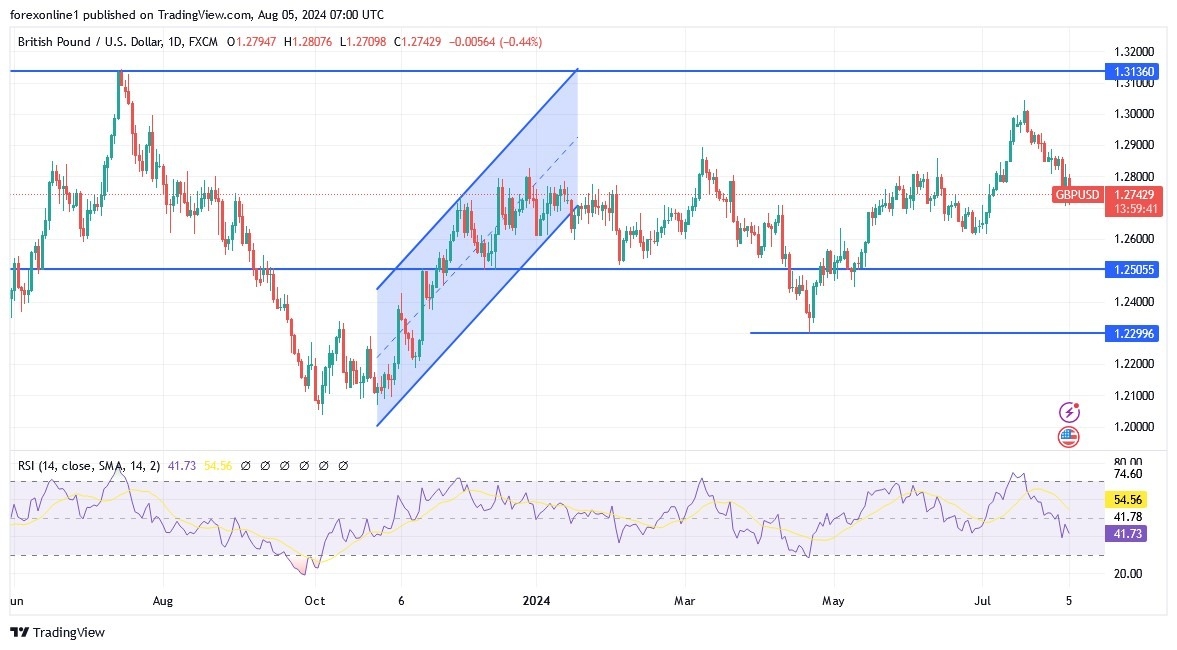GBP/USD Analysis: Bears Still In Control
- Despite the rise in the GBP/USD exchange rate following the shock US jobs report and talk of an emergency rate cut by the Federal Reserve, the bears remain in control.
- According to reliable trading platforms, the exchange rate of the pound sterling against the dollar GBP/USD rose and stocks fell after the highly anticipated US jobs report confirmed that unemployment continues to rise as the economy slows.
(Click on image to enlarge)
Accordingly, financial markets have moved to price in 100 basis points of interest rate cuts by the Federal Reserve in 2024 after the unemployment rate in the United States rose to 4.3% in July. Moreover, non-farm payrolls rose by 114,000, down from 179,000 in June and well below analysts’ expectations of 176,000. In general, economists believe that the US Federal Reserve may head towards a large cut of 50 basis points in September or even a cut between meetings.
In this regard, economist Mohamed El-Erian, former CEO of Pimco and current advisor to Allianz and Gramercy, says: "The overall jobs report today is leading markets to point to not one but two concerns: fear of growth, and concern about a Fed policy mistake."
According to forex trading, the US dollar was broadly weaker in response: GBP/USD recovered earlier losses and rose a third of a percent on the day to 1.2840. EUR/USD was up 0.85% at 1.0925 and USD/JPY was down 1.34% at 146.55.
The odds of a 50-basis point rate cut at the September meeting have risen, with market prices showing a probability of more than 30%. According to the official announcement, US private sector companies added a total of 97,000 jobs in July, the weakest since March 2023, and the average growth in private sector payrolls for three months (142,000 jobs) fell to the lowest level since January 2021.
Also, Stock markets fell sharply on the results of this data, as investors fear that the Federal Reserve has allowed the US interest rate cut too late. Consequently, this in turn weighs on the pound sterling. Moreover, rising expectations of a Fed rate cut tend to cause a similar outcome to the Bank of England’s expectations. This helps explain why the pound sterling fell against a range of other currencies.
An Emergency Rate Cut?
Analysts say, "Financial markets are nervous. The question is whether a recession will occur in the US after 'everything is raised'." They explain that job creation is still at a relatively strong level, although job creation is no longer on par with previous months, and there are clear signs of a slowdown in the US labor market.
On Friday, average hourly earnings rose 0.2% on a monthly basis in July, lowering the annual growth rate to 3.6% and indicating that the labor market is posing a fading inflationary threat. According to analysts at Capital Economics, "In short, all of this makes a September rate cut seem certain and increases the likelihood of a larger 50 basis point cut or even an inter-meeting cut." Nick Timiraos, chief economics correspondent for The Wall Street Journal, points out that at their June meeting, the Fed officials had a 4.0% unemployment rate. Therefore, only 3 out of 19 banks expected the unemployment rate to exceed 4.1% by the end of the fourth quarter according to their baseline forecasts (which assumed one or two cuts this year). None of them expected it to exceed 4.3% in 2025-2026.
In short, employment is significantly weaker than policymakers expected. At the July 31 FOMC meeting, Fed policymakers effectively committed to cutting interest rates in September.
Fed Chairman Jerome Powell said in last Wednesday's policy update, "A cut in our policy interest rate may well be on the table by the time of our next meeting in September." Likewise, he cited concerns about a weakening labor market as justification for a cut before core inflation falls to 2.0% on a sustained basis. Thus, financial markets suggest the Fed may be a bit behind the curve and may now need to catch up.
This could affect the dollar in the future.
Peter Chia, head of FX analysis at UOB, says, "We reaffirm our base view that the US dollar, as well as short-term interest rates and long-term bond yields, should start to decline more significantly during the third quarter, once the Fed embarks on a rate-cutting cycle in September." He added, "Our updated forecasts point to a stronger rise in the EUR/USD and GBP/USD pairs to 1.15 and 1.36, respectively, by the second quarter of 2025."
Technical forecasts for the GBP/USD pair today:
Despite last Friday's gains, the general trend for the Sterling against the US Dollar (GBP/USD) price remains bearish. As we mentioned before, stability below the 1.2800 level will continue to support the bears' control over the trend and thus prepare for stronger losses. Moreover, we still prefer to sell the Sterling Dollar from every rising level. Technically, there will be no strong chance for the pair to change its direction according to the performance on the daily chart to bullish without moving towards the psychological resistance of 1.3000. Ultimately, we expect a quiet trading session in light of the absence of economic calendar releases Important and influential factors on the pound or dollar.
More By This Author:
USD/JPY Analysis: Future Of The Downward Channel FormationGBP/USD Analysis: Will the Bank of England Change Policy?
USD/JPY Analysis: Yen Strength As Dollar Dips
Disclosure: DailyForex will not be held liable for any loss or damage resulting from reliance on the information contained within this website including market news, analysis, trading signals ...
more



